Topics
Category
Era
Duluth Ship Canal Opening, 1871
According to legend, the Duluth ship canal was completed in three days. As the legend goes, every man, woman, and child in the city grabbed a shovel to help dig the canal. Why the rush? They were worried that the action would be halted by an injunction from Superior, Wisconsin. The reality is less dramatic, but the opening of the Duluth ship canal in 1871 was still a historical turning point for the city of Duluth, Minnesota, and the Twin Ports of Duluth and Superior.
Since the 1850s, Duluth boosters had wanted to build a canal at the north end of Superior Bay. Minnesota's Point was ceded to the United States by the Ojibwe in 1854. By 1857, Duluth businessmen had a plan to build a canal. Their plan was dashed by the financial panic of the day, but they knew that a canal was necessary to make Duluth the primary port of Superior Bay.
After the Civil War, the US Army Corps of Engineers got involved. The natural entry to the bay was shallow and difficult to navigate. Ships bringing supplies to the railroad terminus in Duluth began running aground. In 1865, the Corps built a breakwater to protect Duluth's outer harbor, and in 1869, it made three recommendations for improving the harbor. Building a canal was one of them, but the Corps warned that a canal might divert the flow of the St. Louis River and damage the already hazardous natural approach to the bay.
Duluth boosters and railroad interests were determined to build a canal, despite the Corps' warning. The natural entry favored Superior, Wisconsin, but the canal would make Duluth the more accessible port.
Duluth began digging the canal in the fall of 1870. Superior threatened to file for an injunction—a court order that would require Duluth to stop digging. Superior argued that the canal would damage its harbor. Work on the canal stopped during the winter but resumed by late April 1871. Superior filed for its injunction, but by the end of April, the digging was almost done.
On April 29, however, the steam dredger being used to dig the canal was stalled by frozen gravel near the lakeshore. To free the dredger, Duluth residents went to work with shovels and dynamite. Working by hand over the course of several days, they opened the canal just wide enough to let nature finish the job. The pressure of water flowing from the bay into the lake deepened and widened the canal. According to most reports, on May 6, the small steam tug Frank C. Fero was the first boat through the canal.
Duluth continued to enlarge the canal using the steam dredger, as Superior worked to have its injunction request heard in court. The request was finally heard in June 1871. The court ruled that construction on the canal should cease, since federal appropriations had paid for improvements in Superior's harbor and those improvements were threatened by the canal.
The injunction never halted work on the canal, however. The injunction was dissolved after Duluth promised to build a dike to restore the natural entry to Superior Bay. The dike was built, but it was not ultimately needed, since the natural entry to the bay was not damaged by the canal. The dike was harmed by a mysterious 1872 explosion and years of storm and ice damage, and its remains were removed in 1896.
Duluth residents did work by hand to finish the canal in a hurry, but the story quickly became more dramatic than the reality. Legend holds that Superior's injunction was granted before the canal was completed. An "army man" was on the way to enforce it, but he was a three-day train ride away. Duluth banded together as a community to finish the canal in defiance of the injunction. This exaggerated version of the story was first recorded in print in 1925, but it likely circulated orally before that.
In 1873, the harbors of Duluth and Superior came under federal jurisdiction, and in 1896, they were joined under the authority of the Duluth-Superior Harbor Authority. New piers and other harbor improvements were made during the 1890s and early 1900s. In 1905, the canal was bridged by the Duluth Aerial Ferry Bridge—the second of its kind in the world. As of 2011, both the canal and the bridge remain important to the landscape and function of the Twin Ports.
Bibliography
Campbell, Clifford W. "How the Twin Ports Rivalry Started." Duluth News-Tribune, December 16, 1945.
Cooley, Jerome Eugene. Recollections of Early Days in Duluth. Duluth: Jerome Eugene Cooley, 1925. (Editor's Note: This is the first printed version of the exaggerated story that the canal was dug in three days while an "army man" traveled to Duluth.)
Holmquist, June Drenning, and Jean A. Brookins. Minnesota's Major Historic Sites: A Guide. St. Paul: Minnesota Historical Society, 1972.
P1765
Materials relating to the history of the Duluth Aerial Bridge, 1870–1936
Manuscript Collection, Minnesota Historical Society, St. Paul
Description: Typed copies of materials relating to the Duluth Aerial Bridge, collected by the Minnesota Historical Records Survey, as part of the Works Projects Administration. Included are reports regarding the building of the canal through Minnesota Point, related litigation, and the construction of the aerial lift bridge over the canal.
Related Resources
Primary
"The Canal Through Minnesota Point." Duluth Minnesotian, June 11, 1870.
"Superior!" Duluth Weekly Democrat, May 2, 1871.
Young, Frank A. Duluth's Ship Canal and Aerial Bridge: How They Came to Be. Duluth, MN: Stewart-Taylor Company, 1977.
A/.C597
Ethan C. Clarke and Family Papers, 1856–1903
Manuscript Collections, Minnesota Historical Society, St. Paul
Description: Deeds, legal papers, tax receipts, mortgages, and correspondence concerning real estate in the Duluth-Superior area of Minnesota and Wisconsin owned by Clarke, a resident of Washington, DC. Includes materials on the controversy over the construction of the Duluth Ship Canal (1870s–1880s).
G 4144 .D9 1891 .R63 6F
Map Collection, Minnesota Historical Society, St. Paul https://www.mnhs.org/search/collections/record/90a0167c-5d65-4ede-ae29-3495392a987c Description: Roe, Frederick B. Albertson's map of the city of Duluth, St. Louis County, Minn., and vicinity. Albertson and Chamberlain, 1891.
Secondary
Historic American Engineering Projects, 1882–1998
Historic American Buildings Survey Records, Minnesota Historical Society, St. Paul
http://www2.mnhs.org/library/findaids/00251.xml
Description: Project files, including photographs, architectural drawings, project reports, microfiche, correspondence, and miscellaneous papers documenting historically significant districts, buildings, bridges, and other structures in Minnesota, including the Duluth ship canal.
Lanegran, David A., and Carol Louise Urness. Minnesota on the Map: A Historical Atlas. St. Paul: Minnesota Historical Society Press, 2008.
Walker, David A., and Stephen P. Hall. Duluth-Superior Harbor Cultural Resources Study. St. Paul: Department of the Army, 1976.
Related Images
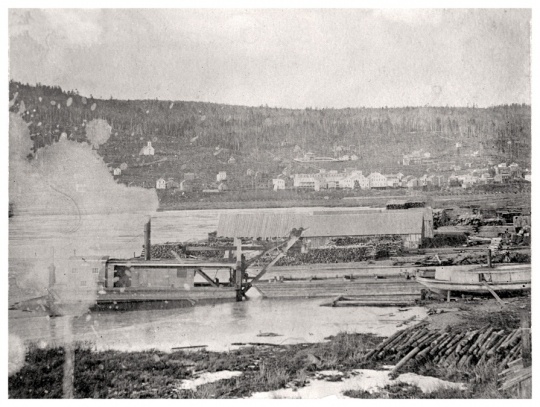
Duluth ship canal being dug
Public domain
Holding Location
Articles
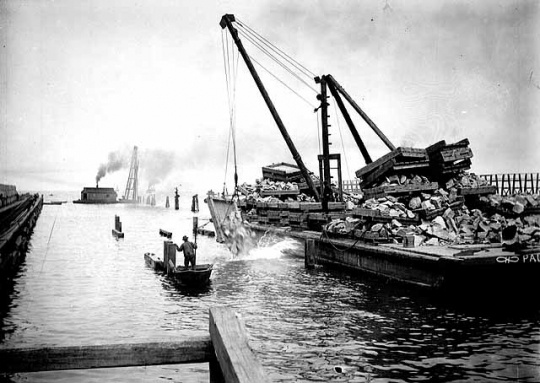
Rocks dropped from loaded barges, Duluth ship canal
Public domain
Holding Location
Articles

The twin ports, Superior, Wisconsin, Duluth, Minnesota
Public domain
Holding Location
Articles
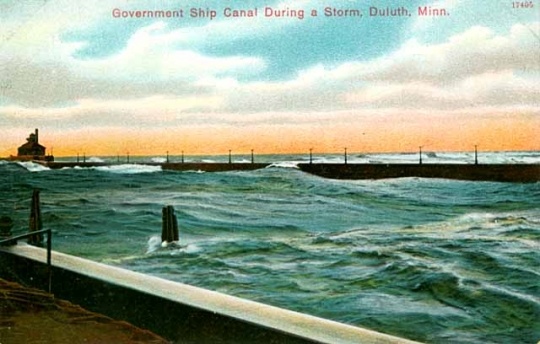
Government ship canal during a storm, Duluth, Minn.
Holding Location
Articles
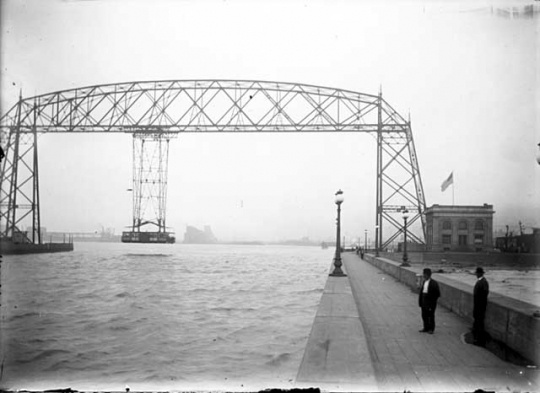
Aerial ferry bridge at Duluth
Public domain
Holding Location
Articles
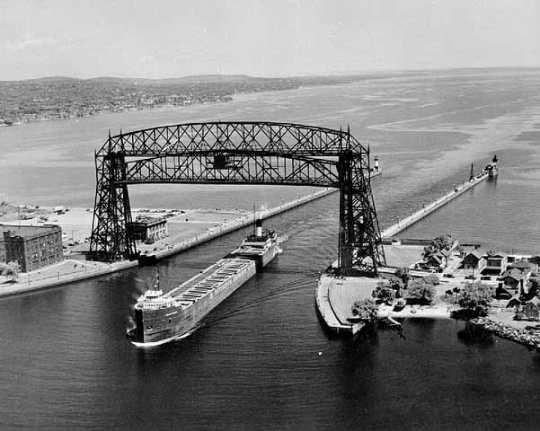
Aerial view of Duluth Lift Bridge, Duluth
All rights reserved
Holding Location
Articles
Related Articles
Turning Point
In April 1871, after a steam dredge gets stuck in frozen gravel near the lakeshore, Duluth residents work by hand to quickly complete the Duluth Ship Canal.
Chronology
1857
1869
1870
1871
1873
1905
Bibliography
Campbell, Clifford W. "How the Twin Ports Rivalry Started." Duluth News-Tribune, December 16, 1945.
Cooley, Jerome Eugene. Recollections of Early Days in Duluth. Duluth: Jerome Eugene Cooley, 1925. (Editor's Note: This is the first printed version of the exaggerated story that the canal was dug in three days while an "army man" traveled to Duluth.)
Holmquist, June Drenning, and Jean A. Brookins. Minnesota's Major Historic Sites: A Guide. St. Paul: Minnesota Historical Society, 1972.
P1765
Materials relating to the history of the Duluth Aerial Bridge, 1870–1936
Manuscript Collection, Minnesota Historical Society, St. Paul
Description: Typed copies of materials relating to the Duluth Aerial Bridge, collected by the Minnesota Historical Records Survey, as part of the Works Projects Administration. Included are reports regarding the building of the canal through Minnesota Point, related litigation, and the construction of the aerial lift bridge over the canal.
Related Resources
Primary
"The Canal Through Minnesota Point." Duluth Minnesotian, June 11, 1870.
"Superior!" Duluth Weekly Democrat, May 2, 1871.
Young, Frank A. Duluth's Ship Canal and Aerial Bridge: How They Came to Be. Duluth, MN: Stewart-Taylor Company, 1977.
A/.C597
Ethan C. Clarke and Family Papers, 1856–1903
Manuscript Collections, Minnesota Historical Society, St. Paul
Description: Deeds, legal papers, tax receipts, mortgages, and correspondence concerning real estate in the Duluth-Superior area of Minnesota and Wisconsin owned by Clarke, a resident of Washington, DC. Includes materials on the controversy over the construction of the Duluth Ship Canal (1870s–1880s).
G 4144 .D9 1891 .R63 6F
Map Collection, Minnesota Historical Society, St. Paul https://www.mnhs.org/search/collections/record/90a0167c-5d65-4ede-ae29-3495392a987c Description: Roe, Frederick B. Albertson's map of the city of Duluth, St. Louis County, Minn., and vicinity. Albertson and Chamberlain, 1891.
Secondary
Historic American Engineering Projects, 1882–1998
Historic American Buildings Survey Records, Minnesota Historical Society, St. Paul
http://www2.mnhs.org/library/findaids/00251.xml
Description: Project files, including photographs, architectural drawings, project reports, microfiche, correspondence, and miscellaneous papers documenting historically significant districts, buildings, bridges, and other structures in Minnesota, including the Duluth ship canal.
Lanegran, David A., and Carol Louise Urness. Minnesota on the Map: A Historical Atlas. St. Paul: Minnesota Historical Society Press, 2008.
Walker, David A., and Stephen P. Hall. Duluth-Superior Harbor Cultural Resources Study. St. Paul: Department of the Army, 1976.







